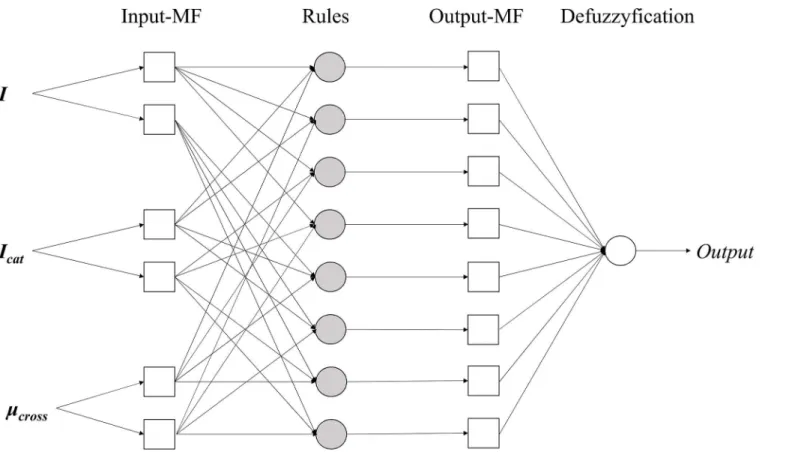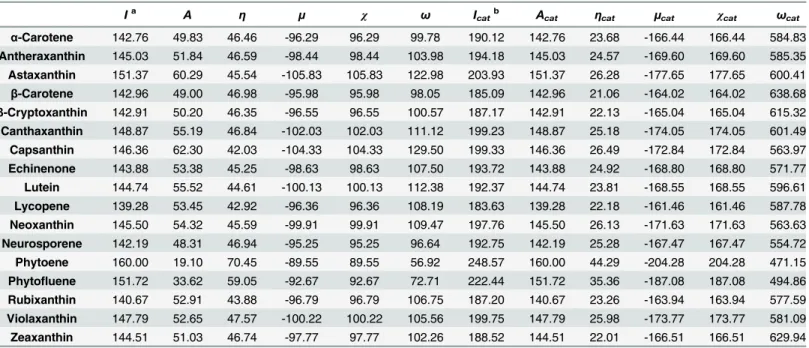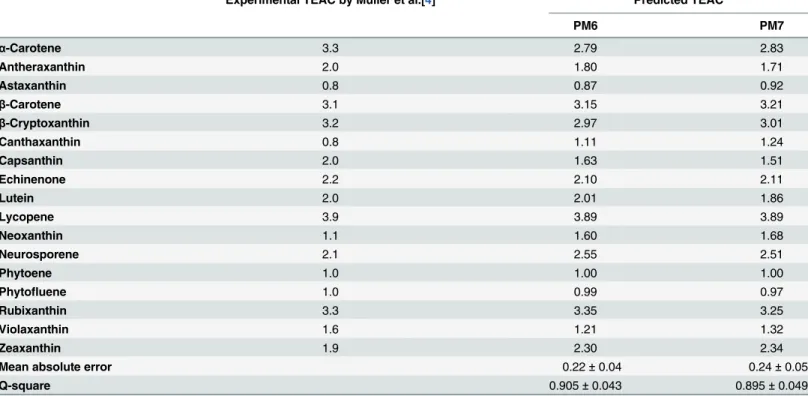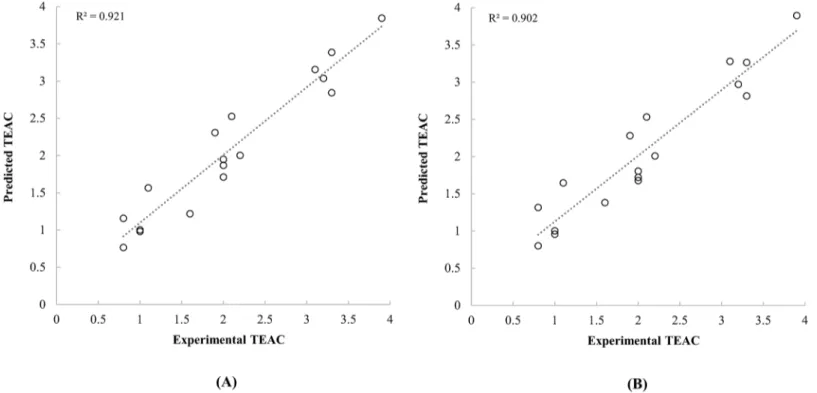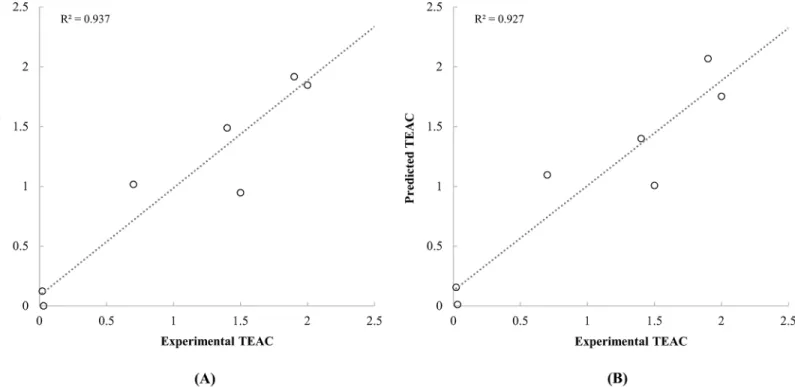Adaptive Neuro-Fuzzy Inference System
Applied QSAR with Quantum Chemical
Descriptors for Predicting Radical Scavenging
Activities of Carotenoids
Changho Jhin, Keum Taek Hwang*
Department of Food and Nutrition, Research Institute of Human Ecology, Seoul National University, Seoul, Korea
*keum@snu.ac.kr
Abstract
One of the physiological characteristics of carotenoids is their radical scavenging activity. In this study, the relationship between radical scavenging activities and quantum chemical descriptors of carotenoids was determined. Adaptive neuro-fuzzy inference system (ANFIS) applied quantitative structure-activity relationship models (QSAR) were also developed for predicting and comparing radical scavenging activities of carotenoids. Semi-empirical PM6 and PM7 quantum chemical calculations were done by MOPAC. Ionisation energies of neutral and monovalent cationic carotenoids and the product of chemical poten-tials of neutral and monovalent cationic carotenoids were significantly correlated with the radical scavenging activities, and consequently these descriptors were used as indepen-dent variables for the QSAR study. The ANFIS applied QSAR models were developed with two triangular-shaped input membership functions made for each of the independent variables and optimised by a backpropagation method. High prediction efficiencies were achieved by the ANFIS applied QSAR. The R-square values of the developed QSAR mod-els with the variables calculated by PM6 and PM7 methods were 0.921 and 0.902, respec-tively. The results of this study demonstrated reliabilities of the selected quantum chemical descriptors and the significance of QSAR models.
Introduction
Carotenoids are natural pigments that have various physiological activities such as conversion to vitamin A and immunological activities [1–3]. One of the important physiological activities of carotenoids is their radical scavenging activity [4–7]. The radical scavenging activity of carotenoids, mainly contributed by conjugated polyene structures of carotenoids [8], is related with direct quenching of singlet oxygen and radical species [9,10]. On the other hand, quantita-tive structure-activity relationship (QSAR) studies regarding antioxidant activities and radical scavenging activities of natural products have been conducted to understand radical scavenging OPEN ACCESS
Citation:Jhin C, Hwang KT (2015) Adaptive Neuro-Fuzzy Inference System Applied QSAR with Quantum Chemical Descriptors for Predicting Radical Scavenging Activities of Carotenoids. PLoS ONE 10 (10): e0140154. doi:10.1371/journal.pone.0140154
Editor:Rafael Vazquez-Duhalt, Center for Nanosciences and Nanotechnology, MEXICO
Received:June 24, 2015
Accepted:September 22, 2015
Published:October 16, 2015
Copyright:© 2015 Jhin, Hwang. This is an open access article distributed under the terms of the
Creative Commons Attribution License, which permits unrestricted use, distribution, and reproduction in any medium, provided the original author and source are credited.
Data Availability Statement:All relevant data are within the paper.
Funding:The authors have no support or funding to report.
mechanisms and to predict the activities [11–13]. The quantum chemical descriptors (such as ionisation energy, electrophilicity, highest occupied molecular orbital (HOMO) and lowest unoccupied molecular orbital (LUMO) energies, etc.) have been used as independent variables in QSAR studies, because the quantum chemical descriptors characterise electronic and geo-metric properties of molecules which affect activities of the molecules [14]. There have been QSAR studies on antioxidant activities of carotenoids [15,16]; however, correlation between various quantum chemical descriptors and antioxidant activities of carotenoids have not been reported. Since quantum chemical descriptors represent physicochemical properties of mole-cules, QSAR models for antioxidant activities of carotenoids could be developed by using their quantum chemical descriptors.
The relationship between radical scavenging activity and quantum chemical descriptors was studied previously [12,14,17–19]. The relationship between quantum chemical descriptors and the radical scavenging activities can be explained theoretically. Radical species could be scav-enged by single electron transfer from a radical scavenger [20]. In a physicochemical manner, it is considered that compounds with low ionisation energy tend to be good radical scavengers because electron transfer from the HOMO of a radical scavenger to the single occupied molec-ular orbital (SOMO) of a radical is occurred more easily on the compounds with a lower ionisa-tion energy compared to the compounds with a higher ionisaionisa-tion energy [14]. In case of nucleophilic radical species, the radical scavenging reaction is attributed to the interaction between SOMO of a radical and the LUMO of a radical scavenger [21,22]. According to Koop-mans’theorem [23], the energy level of LUMO is a negative electron affinity; therefore, a com-pound with a higher electron affinity tends to be attacked easily by a nucleophilic radical. The energy level of the SOMO of radical is dropped by interaction with the LUMO of a radical scav-enger, followed by single electron transfer from HOMO of radical scavenger to the SOMO of radical to scavenge it. The low HOMO-LUMO gap allows electron transfer from HOMO more easily. Since the concept of chemical hardness is based on the HOMO-LUMO gap [24], com-pounds with low chemical hardness tend to have high radical scavenging activity [13,14]. In addition, the driving force for electron transfer is chemical potential (negative electronegativ-ity), which is the slope of the energy versus number of electron curve [25]. In this manner, the chemical potential indicates the rate and the direction of chemical reactions including the radi-cal scavenging activity.
Linear regression method is usually applied to develop QSAR models in several studies [13,15–17,26]; however, the interaction effect between independent variables and nonlinear relationships could not be interpreted easily by the linear regression method. Adaptive neuro-fuzzy inference system (ANFIS) is an artificial neural network (ANN) applied neuro-fuzzy inference system. ANFIS is an empirical method that defines rules by training and backpropagation pro-cesses, and multivariate nonlinear relationship could be solved by fuzzy if-then rules [27]. Thus, in this study, ANFIS applied QSAR models were developed with quantum chemical descriptors for predicting and analysing antioxidant activities of carotenoids.
Materials and Methods
Data set
Fig 1. Carotenoid structures presented by Müller et al. [4].
Molecular structure preparation
The structures of all-transα-carotene, antheraxanthin, astaxanthin,β-carotene,β -cryptox-anthin, canthax-cryptox-anthin, caps-cryptox-anthin, echinenone, lutein, lycopene, neox-cryptox-anthin, neurosporene, phytoene, phytofluene, rubixanthin, violaxanthin and zeaxanthin were obtained from ZINC database [29] as mol2 format and converted into MOPAC input format by Openbabel [30].
Quantum chemical calculations
Semi-empirical PM6 [31] and PM7 [32] quantum chemical calculations were done by MOPAC2012 [33]. The heat of formation of structurally optimised carotenoid molecules was retrieved from MOPAC output files. The quantum chemical properties of ionisation energy (I), electron affinity (A), chemical hardness (η), electronegativity (χ), chemical potential (μ) and electrophilicity (ω) were calculated as following equations:
I¼EðN 1Þ EðNÞ ð1Þ
A¼EðNÞ EðNþ1Þ ð2Þ
η¼ ðI AÞ=2 ð3Þ
χ¼ μ¼ ðIþAÞ=2 ð4Þ
ω¼μ2=2η ð5Þ
whereE(N)is energy of neutral carotenoid molecule,E(N–1)is energy of monovalent carot-enoid cation, andE(N+ 1)is energy of monovalent anion.
Likewise of the quantum chemical properties of neutral carotenoid molecules, the ionisation energy (Icat), electron affinity (Acat), chemical hardness (ηcat), electronegativity (χcat), chemical
potential (μcat) and electrophilicity (ωcat) of monovalent cationic carotenoid molecules were
calculated. To analyse cross-level effects between neutral and cationic carotenoid molecules, the cross-product terms of quantum chemical property values of neutral carotenoid molecules and those of cationic carotenoid molecules were calculated and abbreviated as ionisation energy (Icross), electron affinity (Across), chemical hardness (ηcross), electronegativity (χcross),
chemical potential (μcross) and electrophilicity (ωcross).
Quantitative structure-activity relationship
Correlation analysis. Prior to developing QSAR models, Pearson’s correlation analysis between quantum chemical properties and antioxidant activities of carotenoids was done by using GNU R (http://cran.r-project.org/). Quantum chemical properties highly correlated with antioxidant activities were selected as independent variables for QSAR models.
Adaptive neuro-fuzzy inference system. In order to develop QSAR models, ANFIS was applied using Matlab 8.2 (Mathworks, Natick, MA, USA). From the correlation analysis,I,Icat
andμcrosswere chosen as independent variables for QSAR models. Each independent variable
was standardised to be adjusted to the same scale by following equation:
xstd i ¼
xi x
PN
i¼1ðxi xÞ
2
=N ð6Þ
wherexstd
i is standardised value of the sample,xiis original value of the sample,xis the mean
Two triangular-shaped membership functions were applied for each independent variable, 8 if-then rules and 8 linear type output functions were applied for ANFIS. To train and opti-mise ANFIS models, back-propagation method was used. The structure of ANFIS is illustrated onFig 2. To validate constructed QSAR models, 1000 times of bootstrap resampling validation procedure were applied. To measure prediction efficiency, mean absolute error (MAE) was cal-culated as follows:
MAE¼1
N
Pn i¼1jy
0
i yij ð7Þ
wherey0
iis predicted value resulted from QSAR model andyiis experimental value from the
literature.
Results and Discussion
Correlation analysis
The molecular structures and the list of carotenoids adapted from the study of Müller et al. [4] are illustrated inFig 1, and their calculated quantum chemical properties by PM6 method are presented inTable 1. The quantum chemical descriptors of monovalent cationic carotenoid molecules were also calculated because both of the neutral and monovalent cationic carotenoid molecules exist at the same time during the radical scavenging reaction [34,35]. In addition, the cross-product terms should be calculated and introduced including interaction effects between neutral and cationic carotenoid molecules on QSAR models.
Fig 2. Developed adaptive neuro-fuzzy inference system (ANFIS) structure.
Pearson’s correlation coefficients between TEAC values of carotenoids from Müller et al. [4] and quantum chemical properties calculated by PM6 and PM7 methods are presented in Table 2. The correlations analysed by both of the PM6 and PM7 methods showed identical ten-dencies. The negative correlation between the TEAC and calculatedIvalue could be explained in physicochemical manner. Due to conjugation of double bonds on the long carbon chain skeleton of carotenoids, carotenoids oxidise easily via electron transfer mechanism [6–8,36]. Since electron transfer is a main mechanism of antioxidant activity of carotenoids, carotenoids with lowerIare expected to have higher antioxidant capacity compared to carotenoids with Table 1. Molecular quantum chemical properties of carotenoids calculated by PM6 semi-empirical quantum chemistry method (kcal/mol).
Ia A η μ χ ω Icatb Acat ηcat μcat χcat ωcat
α-Carotene 142.76 49.83 46.46 -96.29 96.29 99.78 190.12 142.76 23.68 -166.44 166.44 584.83
Antheraxanthin 145.03 51.84 46.59 -98.44 98.44 103.98 194.18 145.03 24.57 -169.60 169.60 585.35
Astaxanthin 151.37 60.29 45.54 -105.83 105.83 122.98 203.93 151.37 26.28 -177.65 177.65 600.41
β-Carotene 142.96 49.00 46.98 -95.98 95.98 98.05 185.09 142.96 21.06 -164.02 164.02 638.68
β-Cryptoxanthin 142.91 50.20 46.35 -96.55 96.55 100.57 187.17 142.91 22.13 -165.04 165.04 615.32
Canthaxanthin 148.87 55.19 46.84 -102.03 102.03 111.12 199.23 148.87 25.18 -174.05 174.05 601.49
Capsanthin 146.36 62.30 42.03 -104.33 104.33 129.50 199.33 146.36 26.49 -172.84 172.84 563.97
Echinenone 143.88 53.38 45.25 -98.63 98.63 107.50 193.72 143.88 24.92 -168.80 168.80 571.77
Lutein 144.74 55.52 44.61 -100.13 100.13 112.38 192.37 144.74 23.81 -168.55 168.55 596.61
Lycopene 139.28 53.45 42.92 -96.36 96.36 108.19 183.63 139.28 22.18 -161.46 161.46 587.78
Neoxanthin 145.50 54.32 45.59 -99.91 99.91 109.47 197.76 145.50 26.13 -171.63 171.63 563.63
Neurosporene 142.19 48.31 46.94 -95.25 95.25 96.64 192.75 142.19 25.28 -167.47 167.47 554.72
Phytoene 160.00 19.10 70.45 -89.55 89.55 56.92 248.57 160.00 44.29 -204.28 204.28 471.15
Phytofluene 151.72 33.62 59.05 -92.67 92.67 72.71 222.44 151.72 35.36 -187.08 187.08 494.86
Rubixanthin 140.67 52.91 43.88 -96.79 96.79 106.75 187.20 140.67 23.26 -163.94 163.94 577.59
Violaxanthin 147.79 52.65 47.57 -100.22 100.22 105.56 199.75 147.79 25.98 -173.77 173.77 581.09
Zeaxanthin 144.51 51.03 46.74 -97.77 97.77 102.26 188.52 144.51 22.01 -166.51 166.51 629.94
aI
,A,η,μ,χ,andωare ionisation energy, electron affinity, chemical hardness, chemical potential, electronegativity, and electrophilicity of neutral carotenoid, respectively.
bI
cat,Acat,ηcat,μcat,χcat, andωcatare ionisation energy, electron affinity, chemical hardness, chemical potential, electronegativity, and electrophilicity of
cationic carotenoid, respectively.
doi:10.1371/journal.pone.0140154.t001
Table 2. Pearson’s correlation coefficients between radical scavenging activities and quantum chemical descriptors of carotenoids calculated by PM6 and PM7 methods.
PM6 PM7
Neutral Cation Product Neutral Cation Product
Ionisation energy -0.785*** -0.653** -0.683** -0.732*** -0.632** -0.650**
Electron affinity 0.211 -0.785*** 0.099 0.245 -0.732*** 0.150
Chemical hardness -0.440 -0.572* -0.493* -0.434 -0.581* -0.501*
Chemical potential 0.226 0.692** 0.847*** 0.143 0.659** 0.830***
Electronegativity -0.226 -0.692** -0.847*** -0.143 -0.659** -0.830***
Electrophilicity 0.148 0.416 0.226 0.200 0.570* 0.346
*p<0.05 **p<0.01 ***p<0.001
higherI. Not only theI, but also theIcathad a significant correlation with the TEAC. This
result postulates a radical scavenging mechanism of carotenoids that two electrons of a single carotenoid molecule transfer to radical species to scavenge them. Previous studies also reported that carotenoids undergo sequential loss of two electrons in oxidation reaction [34,35,37]. For the reason that theIwas lower than theIcat(Table 1) and theIwas more significantly
corre-lated with the TEAC compared to theIcat(Table 2), electron transfer process from neutral
carotenoid molecule to radical occurs more favourably than that from monovalent carotenoid cation.
Also, a significantly high correlation betweenμcross(-χcross) and TEAC values (p<0.001)
could be noted, but lower significances were observed in the cases ofμandμcation(Table 2).
This result postulates that antioxidant activities of carotenoids were mainly contributed by both of the neutral and cationic carotenoid molecules rather than either of them. Since the chemical potential (negative electronegativity) is a thermodynamic property derived by differ-entiating the energy with respect to the number of electrons [25], it indicates the direction of chemical reactions as a partial free energy. Thus, a positive relationship was observed between the chemical potential and the TEAC. The postulated mechanism of radical scavenging activi-ties of carotenoids with limited information from correlation analysis is related with the sequential donation of two electrons to radical species. Chemical potential,μ, as a driving force for electron transfer [25] is responsible for first electron transfer reaction andμcatis responsible
for the second electron transfer reaction to radical species. The electron transfer occurs not only between the carotenoids and radical species, but also between the neutral and cationic carotenoids [35,38]. The significant relationship betweenμcrossand the TEAC was supposed to
be caused by the interaction effect between the neutral and cationic carotenoids. In this physi-cochemical manner, the quantum chemical descriptor of chemical potential could be applied on QSAR studies. Worachartcheewan et al. [11] introduced chemical potential to predict radi-cal scavenging activities of curcuminoids, and Pasha et al. [17] developed QSAR model for rad-ical scavenging activities of flavonoids with electronegativity as a dependent variable.
From the result of correlation analysis,I,Icat, andμcrosswere selected as dependent variables
To verify the reliabilities of the selected quantum chemical properties (i.e.,I,Icat, andμcross)
and the design of developed QSAR models, QSAR models were developed with radical scav-enging activity data sets from other previous studies. The TEAC values of 8 carotenoid species were adapted from Miller et al. [5] and the EC50 data of 6 carotenoid species were adapted from Jiménez-Escrig et al. [28]. The results from correlation analysis of these data sets are pre-sented inTable 4. TheI,Icat, andμcrossof carotenoids calculated by both of the PM6 and PM7
were significantly correlated with the TEAC values from Miller et al. at p-value below 0.001. Although statistical significances were low on the correlation between experimental EC50 and quantum chemical properties of carotenoids due to a small sample size of the data set by Jiménez-Escrig et al. (n = 6), positive correlations were observed between EC50 and selected quantum chemical properties of carotenoids. A previous QSAR study regarding on radical scavenging activities of carotenoids by Soffers et al. [15] reported a positive relationship between the ionisation energies and the TEAC values using single data set constituted of 9 carotenoids. In addition to the previous study, this positive tendency was also verified using several number of data sets in this study. Kleinová et al. [16] also constructed a QSAR model for electrochemical redox potentials of carotenoids using polarizability as an independent vari-able. Since the polarizability was closely correlated with ionisation energy [43], the use of polar-izability as an independent variable seemed adequate. However, based on electrochemical properties of carotenoids, the results from the previous study could not be directly interpreted to radical scavenging activities of carotenoids. In the present study, the reliabilities of selected quantum chemical properties for predicting radical scavenging activities and the prediction efficiency of ANFIS applied QSAR models were confirmed by applying various data sets (Figs4and5).
Table 3. Experimental and predicted TEAC of carotenoids.
Experimental TEAC by Müller et al.[4] Predicted TEAC
PM6 PM7
α-Carotene 3.3 2.79 2.83
Antheraxanthin 2.0 1.80 1.71
Astaxanthin 0.8 0.87 0.92
β-Carotene 3.1 3.15 3.21
β-Cryptoxanthin 3.2 2.97 3.01
Canthaxanthin 0.8 1.11 1.24
Capsanthin 2.0 1.63 1.51
Echinenone 2.2 2.10 2.11
Lutein 2.0 2.01 1.86
Lycopene 3.9 3.89 3.89
Neoxanthin 1.1 1.60 1.68
Neurosporene 2.1 2.55 2.51
Phytoene 1.0 1.00 1.00
Phytofluene 1.0 0.99 0.97
Rubixanthin 3.3 3.35 3.25
Violaxanthin 1.6 1.21 1.32
Zeaxanthin 1.9 2.30 2.34
Mean absolute error 0.22±0.04 0.24±0.05
Q-square 0.905±0.043 0.895±0.049
Conclusions
Ionisation energies and chemical potentials of neutral and monovalent cationic carotenoid molecules were demonstrated as descriptors that describe the radical scavenging activities of carotenoids. Although some of the previous studies reported a significant relationship between quantum chemical descriptors and radical scavenging activities of phytochemicals [13,15,18], however, any report that analyses the radical scavenging activities of carotenoids quantitatively has not been found. In addition, in this study, molecular properties of cation molecules were Fig 3. Scatter plot between the experimental TEAC of carotenoids reported by Müller et al. [4] and the predicted TEAC based on the quantum chemical descriptors calculated by PM6 (A) and PM7 (B) methods.
doi:10.1371/journal.pone.0140154.g003
Table 4. Pearson’s correlation coefficients between radical scavenging activities and quantum chemical descriptors of carotenoids calculated by PM6 and PM7 methods.
TEAC by Miller et al. [5] EC50 by Jiménez-Escrig et al. [28]
PM6 PM7 PM6 PM7
I -0.923*** -0.917*** 0.892* 0.850*
Icat -0.937*** -0.942*** 0.724 0.812*
μcross -0.892*** -0.914*** 0.830* 0.802
*p<0.05 **p<0.01 ***p<0.001
I, ionisation energy of neutral carotenoid. Icat, ionisation energy of cationic carotenoid.
μcross, product of chemical potential of neutral and monovalent cationic carotenoid.
Fig 4. Scatter plot between the experimental TEAC of carotenoids reported by Miller et al. [5] and the predicted TEAC based on the quantum chemical descriptors calculated by PM6 (A) and PM7 (B) methods.
doi:10.1371/journal.pone.0140154.g004
Fig 5. Scatter plot between the experimental EC50 of carotenoids reported by Jiménez-Escrig et al. [20] and the predicted TEAC based on the quantum chemical descriptors calculated by PM6 (A) and PM7 (B) methods.
calculated for QSAR models as well as neutral molecules. These characteristics could be used in computer-aided drug design (CADD) and cheminformatics areas for predicting and analysing molecular activities. Applying ANFIS on QSAR, high prediction efficiencies were also achieved. The results from this study suggest that the ANFIS could be a practical approach for developing QSAR models. Although the small sample sizes of data sets might weaken the significance of QSAR models, consistent tendencies, which were observed on various data sets, could demon-strate the reliabilities of selected quantum chemical descriptors and the significance of QSAR models.
Author Contributions
Conceived and designed the experiments: CJ KTH. Performed the experiments: CJ. Analyzed the data: CJ. Contributed reagents/materials/analysis tools: CJ KTH. Wrote the paper: CJ KTH.
References
1. Faivre B, Grégoire A, Préault M, Cézilly F, Sorci G. Immune activation rapidly mirrored in a secondary sexual trait. Science. 2003; 300: 103–103. PMID:12677062
2. Blount JD, Metcalfe NB, Birkhead TR, Surai PF. Carotenoid modulation of immune function and sexual attractiveness in zebra finches. Science. 2003; 300: 125–127. PMID:12677066
3. Schwartz JL, Sloane D, Shklar G. Prevention and inhibition of oral cancer in the hamster buccal pouch model associated with carotenoid immune enhancement. Tumor Biol. 1989; 10: 297–309.
4. Müller L, Fröhlich K, Böhm V. Comparative antioxidant activities of carotenoids measured by ferric reducing antioxidant power (FRAP), ABTS bleaching assay (αTEAC), DPPH assay and peroxyl radical
scavenging assay. Food Chem. 2011; 129: 139–148.
5. Miller NJ, Sampson J, Candeias LP, Bramley PM, Rice-Evans CA. Antioxidant activities of carotenes and xanthophylls. FEBS Lett. 1996; 384: 240–242. PMID:8617362
6. El-Agamey A, Lowe GM, McGarvey DJ, Mortensen A, Phillip DM, Truscott TG, et al. Carotenoid radical chemistry and antioxidant/pro-oxidant properties. Arch Biochem Biophys. 2004; 430: 37–48. PMID:
15325910
7. Stahl W, Sies H. Antioxidant activity of carotenoids. Mol Aspects Med. 2003; 24: 345–351. PMID:
14585305
8. Britton G. Structure and properties of carotenoids in relation to function. FASEB J Off Publ Fed Am Soc Exp Biol. 1995; 9: 1551–1558.
9. Cantrell A, McGarvey DJ, George Truscott T, Rancan F, Böhm F. Singlet oxygen quenching by dietary carotenoids in a model membrane environment. Arch Biochem Biophys. 2003; 412: 47–54. PMID:
12646267
10. Krinsky NI, Deneke SM. Interaction of oxygen and oxy-radicals with carotenoids. J Natl Cancer Inst. 1982; 69: 205–210. PMID:6285060
11. Worachartcheewan A, Nantasenamat C, Isarankura-Na-Ayudhya C, Prachayasittikul S, Prachayasitti-kul V. Predicting the free radical scavenging activity of curcumin derivatives. Chemom Intell Lab Syst. 2011; 109: 207–216.
12. Jhin C, Hwang KT. Prediction of radical scavenging activities of anthocyanins applying adaptive neuro-fuzzy inference system (ANFIS) with quantum chemical descriptors. Int J Mol Sci. 2014; 15: 14715– 14727. doi:10.3390/ijms150814715PMID:25153627
13. Kontogiorgis AC, Pontiki AE, Hadjipavlou-Litina D. A review on quantitative structure-activity relation-ships (QSARs) of natural and synthetic antioxidants compounds. Mini Rev Med Chem. 2005; 5: 563– 574. PMID:15974934
14. Karelson M, Lobanov VS, Katritzky AR. Quantum-chemical descriptors in QSAR/QSPR studies. Chem Rev. 1996; 96: 1027–1044. PMID:11848779
15. Soffers AEMF, van Haandel MJH, Boersma MG, Tyrakowska B, Laane C, Rietjens IMCM. Antioxidant activities of carotenoids: quantitative relationships between theoretical calculations and experimental literature data. Free Radic Res. 1999; 30: 233–240. PMID:10711793
16. Kleinová M, Hewitt M, Brezová V, Madden JC, Cronin MTD, Valko M. Antioxidant properties of caroten-oids: QSAR prediction of their redox potentials. Gen Physiol Biophys. 2007; 26: 97–103. PMID:
17. Pasha FA, Cho SJ, Beg Y, Tripathi YB. Quantum chemical QSAR study of flavones and their radical-scavenging activity. Med Chem Res. 2008; 16: 408–417.
18. Sarkar A, Middya TR, Jana AD. A QSAR study of radical scavenging antioxidant activity of a series of flavonoids using DFT based quantum chemical descriptors–the importance of group frontier electron density. J Mol Model. 2011; 18: 2621–2631. doi:10.1007/s00894-011-1274-2PMID:22080306
19. Vasil’ev RF, Kancheva VD, Fedorova GF, Batovska DI, Trofimov AV. Antioxidant activity of chalcones: The chemiluminescence determination of the reactivity and the quantum chemical calculation of the energies and structures of reagents and intermediates. Kinet Catal. 2010; 51: 507–515.
20. Prior RL, Wu X, Schaich K. Standardized methods for the determination of antioxidant capacity and phenolics in foods and dietary supplements. J Agric Food Chem. 2005; 53: 4290–4302. PMID:
15884874
21. Poblet JM, Canadell E, Sordo T. Concerning the orientation in free radical additions to olefins. Can J Chem. 1983; 61: 2068–2069.
22. Park SU, Chung SK, Newcomb M. Acceptor, donor, and captodative stabilization in transition states of 5-hexen-1-yl radical cyclizations. J Am Chem Soc. 1986; 108: 240–244.
23. Koopmans T. Über die Zuordnung von Wellenfunktionen und Eigenwerten zu den Einzelnen Elektro-nen Eines Atoms. Physica. 1934; 1: 104–113.
24. Parr RG, Pearson RG. Absolute hardness: companion parameter to absolute electronegativity. J Am Chem Soc. 1983; 105: 7512–7516.
25. Parr RG, Donnelly RA, Levy M, Palke WE. Electronegativity: the density functional viewpoint. J Chem Phys. 1978; 68: 3801–3807.
26. AmićD, LučićB. Reliability of bond dissociation enthalpy calculated by the PM6 method and experi-mental TEAC values in antiradical QSAR of flavonoids. Bioorg Med Chem. 2010; 18: 28–35. doi:10. 1016/j.bmc.2009.11.015PMID:19944611
27. Jang J-SR. ANFIS: adaptive-network-based fuzzy inference system. IEEE Trans Syst Man Cybern. 1993; 23: 665–685.
28. Jiménez-Escrig A, Jiménez-Jiménez I, Sánchez-Moreno C, Saura-Calixto F. Evaluation of free radical scavenging of dietary carotenoids by the stable radical 2,2-diphenyl-1-picrylhydrazyl. J Sci Food Agric. 2000; 80: 1686–1690.
29. Irwin JJ, Shoichet BK. ZINC-a free database of commercially available compounds for virtual screen-ing. J Chem Inf Model. 2005; 45: 177–182. PMID:15667143
30. O’Boyle NM, Banck M, James CA, Morley C, Vandermeersch T, Hutchison GR. Open babel: an open chemical toolbox. J Cheminformatics. 2011; 3: 33.
31. Stewart JJ. Optimization of parameters for semiempirical methods V: modification of NDDO approxima-tions and application to 70 elements. J Mol Model. 2007; 13: 1173–1213. PMID:17828561
32. Stewart JJ. Optimization of parameters for semiempirical methods VI: more modifications to the NDDO approximations and re-optimization of parameters. J Mol Model. 2013; 19: 1–32. doi: 10.1007/s00894-012-1667-xPMID:23187683
33. Stewart JJP. MOPAC 2012, Colorado Springs, CO: Stewart Computational Chemistry, USA. 2014.
34. Mairanovsky VG, Engovatov AA, Ioffe NT, Samokhvalov GI. Electron-donor and electron-acceptor properties of carotenoids: electrochemical study of carotenes. J Electroanal Chem Interfacial Electro-chem. 1975; 66: 123–137.
35. Jeevarajan JA, Kispert LD. Electrochemical oxidation of carotenoids containing donor/acceptor substit-uents. J Electroanal Chem. 1996; 411: 57–66.
36. Mortensen A, Skibsted LH, Truscott TG. The Interaction of Dietary Carotenoids with Radical Species. Arch Biochem Biophys. 2001; 385: 13–19. PMID:11361009
37. Jeevarajan AS, Khaled M, Kispert LD. Simultaneous electrochemical and electron paramagnetic reso-nance studies of carotenoids: effect of electron donating and accepting substituents. J Phys Chem. 1994; 98: 7777–7781.
38. Edge R, Land EJ, McGarvey D, Mulroy L, Truscott TG. Relative One-Electron Reduction Potentials of Carotenoid Radical Cations and the Interactions of Carotenoids with the Vitamin E Radical Cation. J Am Chem Soc. 1998; 120: 4087–4090.
39. Gemperline PJ, Long JR, Gregoriou VG. Nonlinear multivariate calibration using principal components regression and artificial neural networks. Anal Chem. 1991; 63: 2313–2323.
40. Agatonovic-Kustrin S, Beresford R. Basic concepts of artificial neural network (ANN) modeling and its application in pharmaceutical research. J Pharm Biomed Anal. 2000; 22: 717–727. PMID:10815714 41. Braga-Neto UM, Dougherty ER. Is cross-validation valid for small-sample microarray classification?
42. Kiralj R, Ferreira MMC. Basic validation procedures for regression models in QSAR and QSPR studies: theory and application. J Braz Chem Soc. 2009; 20: 770–787.
![Fig 1. Carotenoid structures presented by Müller et al. [4].](https://thumb-eu.123doks.com/thumbv2/123dok_br/18274981.344951/3.918.51.865.108.1041/fig-carotenoid-structures-presented-müller-et-al.webp)
